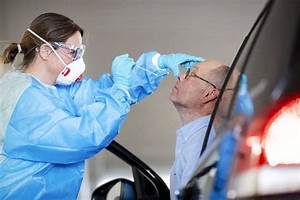 coronavirus,coronavirus testing,CORONAVIRUS TESTING FULL METHOD,-How does testing WORK of coronavirus,testing for the coronavirus work,कोरोना वायरस टेस्टिंग कैसे होती हे
coronavirus,coronavirus testing,CORONAVIRUS TESTING FULL METHOD,-How does testing WORK of coronavirus,testing for the coronavirus work,कोरोना वायरस टेस्टिंग कैसे होती हे
HINDI KE PATRAKR
How does testing WORK of coronavirus?
Who should be tested for the coronavirus — and how? Here's what you need to know about being tested for COVID-19, and what testing may look like in the future.
 |
How does testing WORK of coronavirus?
|
thre are gs or vaccines for the new coronavirus. It will take at least 18 to 24 months before an appropriate vaccine can be developed, tested for side effects in all test phases, approved by the health authorities, and then produced in large quantities and delivered globally. And then people will have to be vaccinated.
However, even in well-developed countries, medical facilities and laboratories quickly reach the limits of their capacity during an acute wave of infection. For this reason, rapid tests must be limited to genuinely suspicious cases; a general test of all is neither possible nor useful.
According to current estimates, simply being in a risk area is not enough to justify a test. And not
everyone with a cold or cough is infected with COVID-19 immediately.
However, anyone who shows signs of virus-induced pneumonia of "unclear cause," anyone who shows conspicuous symptoms such as coughing, fever and shortness of breath and who has also either had contact with an infected person or has stayed in a particularly affected risk region is a justified suspect case.
Ultimately, it is at the discretion of the doctor whether a coronavirus test is carried out or not. According
to the Robert Koch Institute, random samples of patients with flu symptoms are also tested for the novel coronavirus.
In Germany, the costs (approximately €200 or $220) are covered by health insurance companies, but only if the patient is actually classified as a suspected case by the doctor.
“This translates to 11179.83 tests per million (TPM) for India, which has seen a steady increase since the adoption of the ‘test, track and treat’ strategy,” the Ministry said.
The rise in TPM has been achieved with a steady rise in the number of labs (1290 so far) and efforts by the Centre and State governments and Union Territorty administrations to facilitate wide-spread testing through an array of options, it noted.
There are currently 897 labs in the government sector and 393 private labs. As for the country registering increasing number of recoveries, the Ministry said that efforts of States and Union Territories are bolstered by the Central teams of experts sent to high case-load areas and through strategic discussions held by Central government through video conferencing with State- and district officials.

v
“With the dedicated efforts of health-care workers, the recoveries are improving and case fatality is continuously falling, which currently stands at 2.38%,” the Ministry said.
The sustained rise in number of recoveries is the result of a well formulated and executed strategy of containment of COVID-19 by the State and Union Territory governments under the guidance of the Union government.
It primarily focusses on early detection through aggressive testing along with house-to-house surveys, contact-tracing and surveillance of SARI/ILI cases to actively search for cases in the highly vulnerable categories. This is followed by effective containment plans and efficient clinical management through the ramped up three-tier health infrastructure and well executed standard of care protocol.
These have successfully aided in effective treatment in the hospitals and through home isolation which in turn has ensured that the hospitals remain unburdened for critical patients, the Ministry said.
How to get tested for current COVID-19 infection
- To learn if you have a current infection, viral tests are used. Most people have mild illness and can recover at home without medical care. Contact your healthcare provider if your symptoms are getting worse or if you have questions about your health.
- Decisions about testing are made by state and localexternal icon health departments or healthcare providers. You can visit your state or localexternal icon health department’s website to look for the latest local information on testing.
- If you have symptoms of COVID-19 and want to get tested, call your healthcare provider first.
- If you have symptoms of COVID-19 and are not tested, it is important to stay home. Learn what to do if you are sick.
Results
-
- If you test negative for COVID-19 by a viral test, you probably were not infected at the time your sample was collected. However, that does not mean you will not get sick. The test result only means that you did not have COVID-19 at the time of testing. You might test negative if the sample was collected early in your infection and test positive later during your illness. You could also be exposed to COVID-19 after the test and get infected then.


 v
v

![तेज दौड़ने के १० कमाल के तरीके [HOW TO RUN FAST BY 10 TIPS AND TRICK]](https://blogger.googleusercontent.com/img/b/R29vZ2xl/AVvXsEhtvWuVojhNXaqDhnEGVVV9vXirK1AzFO2xTYq73zdcG6Tk5bwet0nkXvWABhxOj889BPsMpzVgw3GCdZPFs3nhlk-U85ddKSFGu7c8NzeHzd-34-OY3HwbltB_P5UL9fgGsKJwYO8-C1V_/s72-c/%25E0%25A4%25A6%25E0%25A5%258C%25E0%25A4%25A1%25E0%25A4%25BC-%25E0%25A4%2595%25E0%25A5%2587-%25E0%25A4%25A4%25E0%25A4%25B0%25E0%25A5%2580%25E0%25A4%2595%25E0%25A5%2587-running-tips-in-hindi-tej-daudne-ka-sahi-tarika+%25281%2529.jpg)







कोई टिप्पणी नहीं:
एक टिप्पणी भेजें